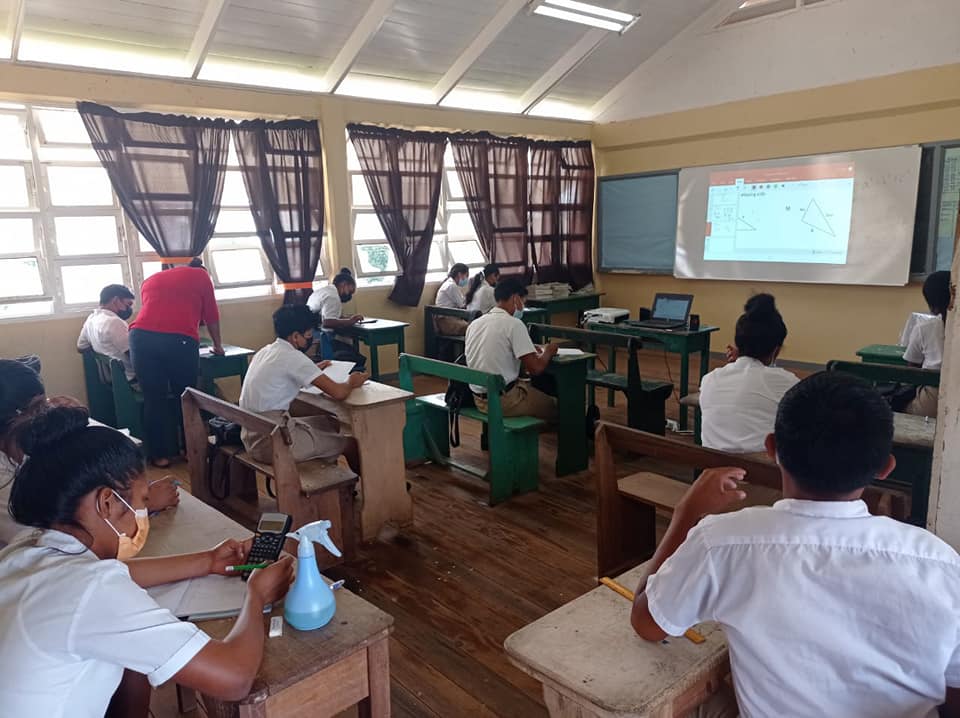It’s Monday morning at the indigenous village of Aishalton, in Guyana’s Deep South Rupununi region. 39-year-old Immaculata Casimero proudly dons a shawl that identifies her Wapichan heritage.
She’s in a rush, but makes sure to pull her mask across her face ahead of the 15 minute trek across the savannah to her daughter Kiarra’s primary school. COVID-19 has changed just about everything in her village, including her daughter’s education. Pandemic lockdowns forced an end to normal classes. Students now work from home with parents filling the roles of teachers as best they can.
Immaculata describes how, on selected days of each week, she visits her daughter’s class teacher for guidance on four core subjects: English, Mathematics, Social Studies and Science. “Parents have to work with their children at home and try to see how best they can educate their children,” she noted.
She said the situation requires the parent to refresh their own knowledge of the subjects. First, the teacher guides and instructs the parent through the entire lesson. When the parent returns, the home becomes the classroom.
“Well the teachers have been doing a fantastic job in my village, especially the primary school teachers, they have been finding ways and means of how to engage children through their parents,” she explained. She described them as the real heroes.
Immaculata is one of the village’s respected indigenous leaders. She praised parents who have stepped up to meet these new obstacles posed by the pandemic.
This morning’s session with Kiarra’s teacher gives Immaculata a clear outline of what classwork her daughter needs to cover in the week ahead.
Afterwards, she carries home a two-inch stack of worksheets. These will help keep lessons on a defined course. Several days later, she returns to the teacher with the completed worksheets in order to assess her child’s performance.
Kiarra is preparing for National Grade Six Assessment (NGSA) examinations in August that will determine whether she advances to secondary level studies. Immaculata recognizes it’s a crucial moment for Kiarra’s future.
A New Leader to Meet New Challenges
304 miles away in the capital city of Georgetown, Marti DeSouza is also hard at work. Like Immaculata and her daughter, he counts himself among Guyana’s indigenous people. Like them, he understands how crucial the upcoming exams will be for her future and the future of the country.
Less than a year ago, DeSouza assumed the post of Deputy Chief Education Officer at the Ministry of Education. In his new role, he became the first indigenous educator to oversee the challenge of improving the quality of learning in Guyana’s so-called Hinterlands. It is a historic first.
“Basically my mandate is to ensure that there is some amount of equity first of all in the distribution of resources and in the delivery of education so that eventually our results, our performance can be equitable with what is happening on the Coastland,” he said of his new role.
DeSouza hopes to bring more internet connectivity, virtual classrooms and a satellite TV downlink to the Hinterlands. He’s also keen on the promise of more teachers for Guyana’s indigenous schools. He says some 2-thousand new teachers are already in training. At least some will be stationed in the Hinterlands.
The Hinterlands refers to those remote areas of Guyana that are home to a majority of its indigenous population along the borders of Brazil, Suriname and Venezuela. Historically, students in these areas have lagged behind those in the more urban, coastal regions.
Overall, Guyanese students are highly competitive with their peers in other countries within the English-speaking Caribbean. Examination results for secondary certificates demonstrate that.
| Year | Trinidad & Tobago | Jamaica | Guyana |
|---|---|---|---|
| 2016 | 67 | 63.6 | 63.39 |
| 2017 | 67.78 | 64.6 | 63.8 |
| 2018 | 68.4 | 69.1 | |
| 2019 | 77 | ||
| 2020 | 76.07 | 76.5 | 75.99 |
Source: Guyana Ministry of Education
Marti DeSouza himself hails from the indigenous village of Santa Rosa in Guyana’s North West District known as Region One. He told the CIJN the COVID-19 pandemic exposed pronounced differences in access to education between the coastal regions and the Hinterland villages.
Challenges and Changes Amid the Pandemic
Remote learning requires exactly what these forested villages of the Hinterland don’t have: a good internet connection. The pandemic has amplified those needs.
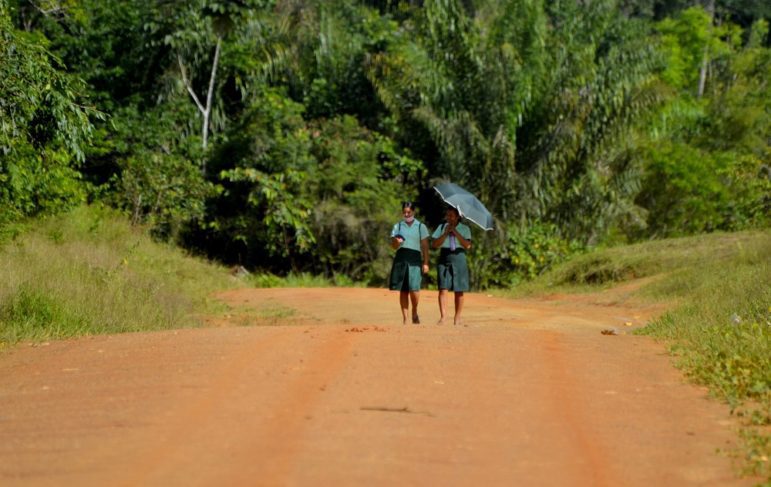
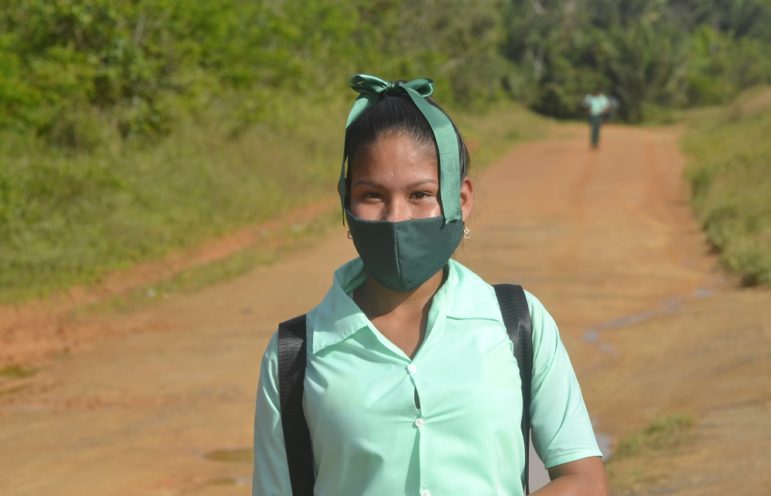
Here, students navigate the red dirt roads alongside other travelers. Reaching these regions is usually accomplished by air or river boats from the coastland. But that’s expensive. Transportation only adds to the obstacles of developing and delivering a modern education experience here.
Mapping an Education Plan for the Hinterlands
Marti DeSouza has taught at the secondary level in the city and the rural villages during his teaching career. He knows too well the job which lies ahead of him. He described his career path thus far as an “adventure” in which he moved from a localised environment to becoming a national figure for students in the Hinterland.
“It is something that I have not backed down from. I have faced all the challenges that have come my way,” say DeSouza, who regularly boards aircraft to reach the more remote regions.
”The time was opportune,” he says to actually forge ahead on education delivery as well as the challenge of COVID-19.
DeSouza wants to reach all 240 indigenous villages across Guyana and improve the education of 33,000 students there.
Aishalton situation
Aishalton has a population of only 1300. In April 2021, it recorded more than two dozen cases of COVID-19 and one death. The entire village of 250 households was locked down for a month.
Despite hardships like that, Immaculata says parents remain positive. The problem is that without internet access or printers, the villages are unable to access what is available on the Ministry’s own website. Since September 2020, the Ministry provided printed copies to teachers, students and their parents.
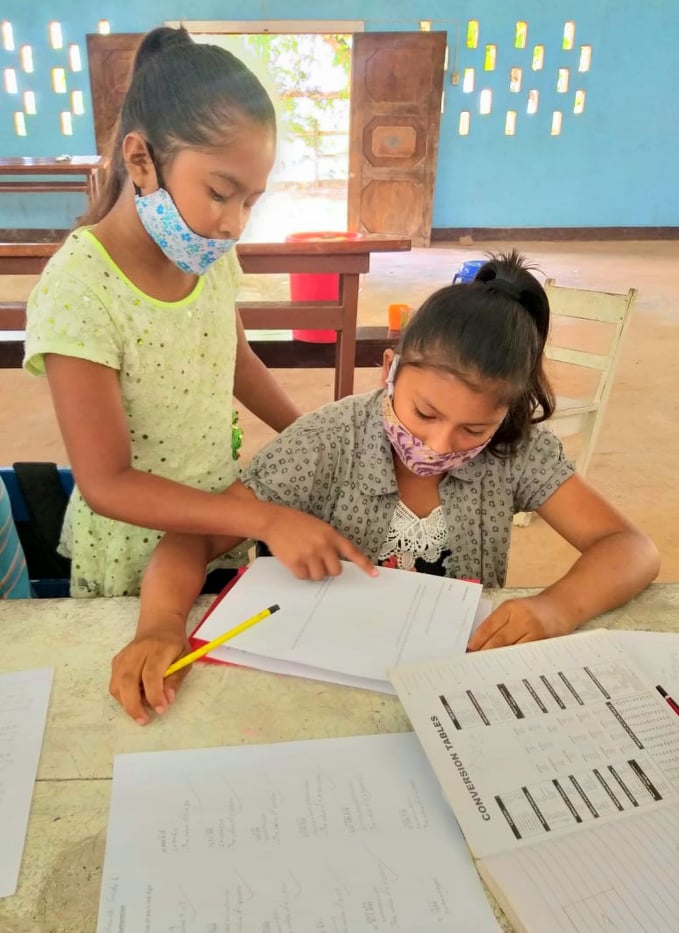
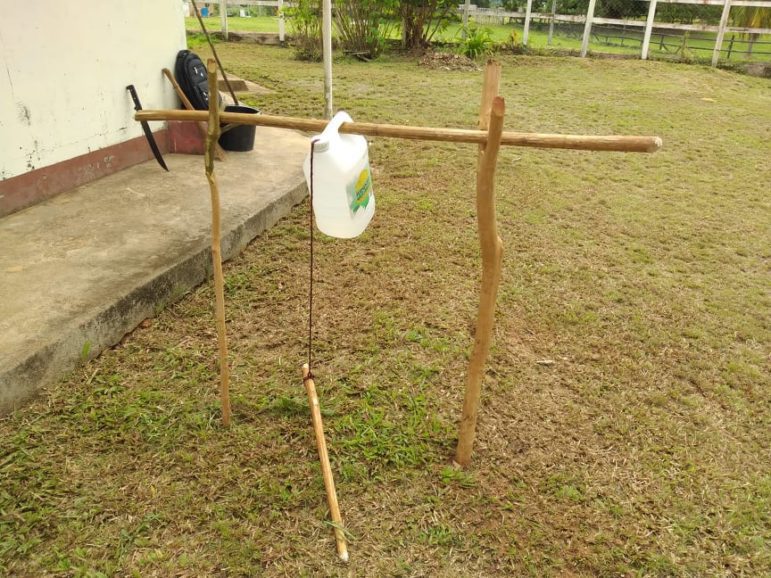
Occasionally , students have been able to visit the school in limited numbers for a more traditional experience. Parents are supportive of government protocols like distancing and hand washing. “We are trying our best to contain the situation, so our students can continue the learning process,” Immaculata Casimero told us.
In some parts of the Rupununi region, wildlife clubs have sprung up to help students who are missing the face-to-face sessions remain engaged. The clubs feature biodiversity tours, wildlife education, traditional crafts and limited classroom work.
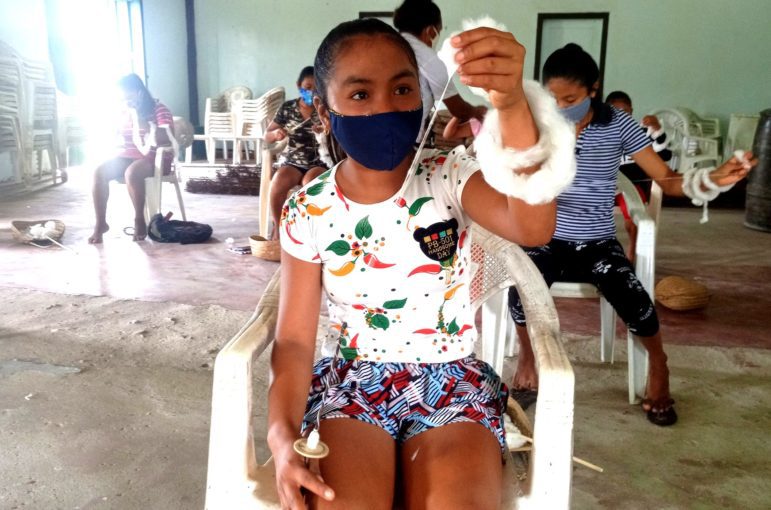
In March this year, more than 240 students in the South and Central Rupununi were enrolled in Traditional Knowledge classes. The students hail from 8 villages. Unfortunately, students in even more remote villages aren’t always able to take part.
The Situation in Region One
The village of White Water lies close to the Venezuelan border more than 500 miles away. Dorothy Samuels, an indigenous Arawak, says she has three school-aged children. Two of her children usually attend primary school in the area while another attends classes in the town of Mabaruma nearby.
Samuels complains that, because of the pandemic, her children have been home for more than a year. She tries to work with them but Samuels and her husband are also scrambling to make ends meet.
Samuels fears her children “dropped back a lot” in their schooling.
Residents at White Water are mainly farmers, hunters or labourers. In the past, families traded items such as sugar and rice across the border with Venezuelan villages. But the economic downturn coupled with the presence of hardened criminals at the border, known as Sindicatos, brought that trade to a halt.
Economic realities confront every family and the luxury of just staying home with the children isn’t an option for many.
Kwebana is another remote village. It is located 75 miles from Whitewater along the Waini River. Here, Keisha Adams studies for her CSEC examinations next year. She said after months of remote learning she is adjusting to being back in the classroom.
Keisha walks 3 miles to and from school every day. It is tiring, she said, but every step will benefit her future. She told CIJN that remote or virtual learning enabled her to cover the entire syllabus for the subjects included in her upcoming exams.
Keisha’s mother, Kenisha Ross, tells us she wants virtual learning to remain in place at remote villages like Kwebana beyond the pandemic.
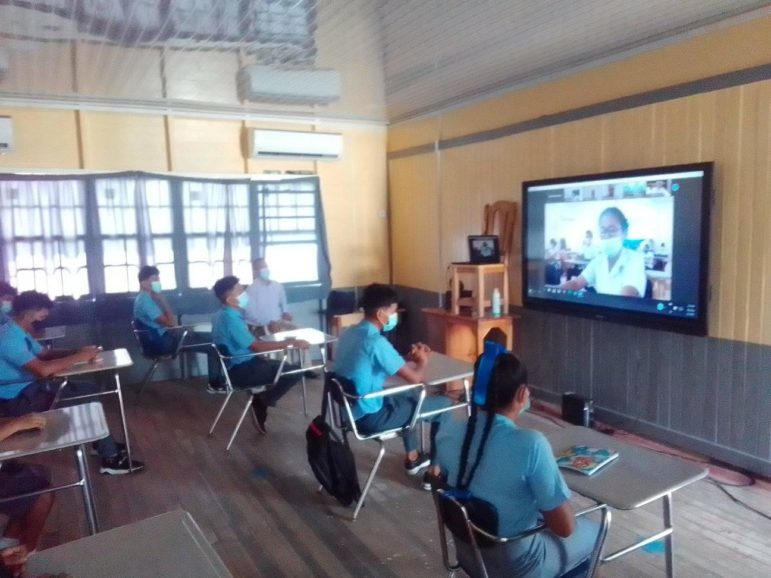
Virtual Learning
Since late February 2021, the secondary students of 13 Hinterland schools have engaged in remote learning. They gather in front of a projector or television screen to share the day’s lessons.
Virtual learning was initially introduced late last year as a means of reaching out to students who were caught up in pandemic lockdowns.
“It’s the new norm, ” DeSouza said of the concept. It is one of the ways COVID-19 has forced Guyana to transform its education system.
There are almost 33,000 students in 239 schools in the Hinterland villages. More than 7,000 of them are secondary students in 13 High Schools.
At the moment almost 33,000 students in the Hinterland villages are affected by the pandemic; only a quarter of them are secondary school students. In total, there are 239 schools in these remote areas, 13 of them are secondary schools.
Marti De Souza says bringing this new system of learning to all secondary students is the priority.
At the moment, he said the Ministry of Education has been able to create a “smart classroom” environment within the Hinterland’s secondary schools. The project benefits from special COVID funding that boosts internet services in remote areas. DeSouza said students are benefitting enormously as a result.
Learning Channel Expansion
Guyana’s government is building new infrastructure for another key project: the Learning Channel. It envisions six cable television channels being connected to remote and rural villages via satellite. Educational programming would be broadcast for children at all grade levels. Even students in remote, sparsely populated areas would be able to benefit.
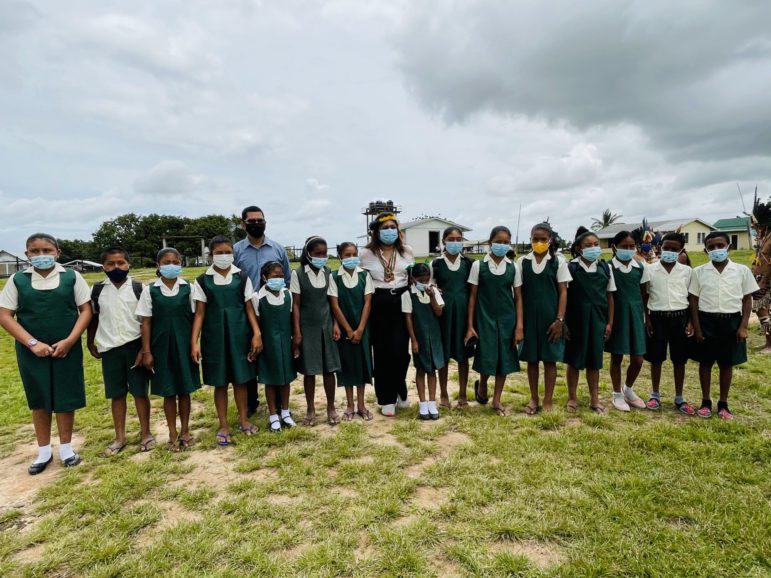
Looking ahead, DeSouza insists there must be standards to ensure human resources for indigenous students in the Hinterland are on par with the coastal regions. This is one of the main reasons there exists a gap in the system, he posited.
DeSouza is optimistic the Hinterland will benefit from at least some of more than 2000 teachers already in training at Guyana’s Cyril Potter College of Education (CPCE).
“That is something I am keenly looking out for,” he told CIJN, vowing to confront remaining challenges head on.
DeSouza says that in the wider scheme of things, there are plans to ensure that every student leaves school with a skill that will take them into a successful future.
COVID-19 has presented many challenges. But Marti DeSousa seems convinced the whole remote learning experience shared by parents, teachers and students could help transform education in the Hinterlands.
“The future looks bright.”
